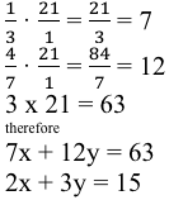You are using an out of date browser. It may not display this or other websites correctly.
You should upgrade or use an alternative browser.
You should upgrade or use an alternative browser.
Solve the system of linear equations
- Thread starter frctl
- Start date
Dr.Peterson
Elite Member
- Joined
- Nov 12, 2017
- Messages
- 16,865
Presumably, you mean:1/3x + 4/7y = 3
2x + 3y = 15
(1/3)x + (4/7)y = 3
2x + 3y = 15
One way to make it easier to get started will be to eliminate the fractions in the first equation, by multiplying both sides by 21 (the LCD).
Try that, and show us your work so we can see where you need help.
pka
Elite Member
- Joined
- Jan 29, 2005
- Messages
- 11,978
Presumably, you mean:
(1/3)x + (4/7)y = 3
2x + 3y = 15
\(\displaystyle \frac{x}{3}+\frac{4y}{7}=3\\7x+12y=63\)Dr.Peterson
Elite Member
- Joined
- Nov 12, 2017
- Messages
- 16,865
No, what you did was to multiply both numerator and denominator of each fraction by 21. That is not what I said. I said to multiply both sides of the equation by 21. (Many students do confuse these ideas.)Trying this I obtain:
(21/69)x + (84/147)y = 3
2x + 3y = 15
If you multiply 1/3 by 21, you get [MATH]\frac{1}{3}\cdot\frac{21}{1} = \frac{21}{3} = 7[/MATH]. The goal of this step, as I said, is to eliminate fractions. Do that to both sides of the equation, and it will become easier to work with. (This isn't essential, but most students have trouble with fractions, and even those who don't wouldn't enjoy these.)
See what pka wrote, which shows the result you should get from this step. Of course, then you still have to solve the system of equations, by eliminating a variable by the method of your choice.
Dr.Peterson
Elite Member
- Joined
- Nov 12, 2017
- Messages
- 16,865
I don't know what you can do; but it can be done.Thank you, I have done as instructed.
View attachment 13355
Can I simplify further and solve for the variables?
What methods have you learned? You can do as pka did and multiply one (or both, in general) of the equations so that, when you add them together, a variable will be eliminated; or you can solve one equation for one of the variables and substitute in the other.
Are you implying that you have learned nothing about solving systems of equations? A site like this is not the best place to learn a topic like that for the first time.
Dr.Peterson
Elite Member
- Joined
- Nov 12, 2017
- Messages
- 16,865
As I indicated, he multiplied the second equation by -4, then added the two equations.
Have you learned anything at all about solving systems? This is a standard method, which he apparently assumed you would recognize when you saw it. The more you tell us about what you have learned, the better we can tailor our responses to your needs.
Have you learned anything at all about solving systems? This is a standard method, which he apparently assumed you would recognize when you saw it. The more you tell us about what you have learned, the better we can tailor our responses to your needs.
pka
Elite Member
- Joined
- Jan 29, 2005
- Messages
- 11,978
\(\displaystyle \left\{ \begin{array}{l} 7x + 12y = 63\\2x +3y=15\end{array} \right. \Rightarrow \left\{ \begin{array}{l} 7x + 12y = 63\\-8x -12y=-60\end{array}\right. \)\(\displaystyle \Rightarrow,~~x=-3\)
To frctl, had I not followed this entire thread, I would be tempted to ask "are you serious?"How did pka arrive at:−8x−12y=−60 and x = -3
You posted \(\displaystyle \left\{ \begin{array}{l} \frac{x}{3}+\frac{4y}{7}=3\\2x +3y=15\end{array} \right.\)
To make matters better we remove fractions
\(\displaystyle \left\{ \begin{array}{l} 7x+12y=63\\2x +3y=15\end{array} \right.\)
Thus we have a system two linear equations in two variables.
The standard way to solve is by way of eliminating one of the two variables.
To do that multiply the second by \(\displaystyle -4\) to get
\(\displaystyle \left\{ \begin{array}{l} \;\;7x+12y=63\\-8x -12y=-60\end{array} \right.\)
Now add those to together to get \(\displaystyle -x=3\text{ or }x=-3\)

